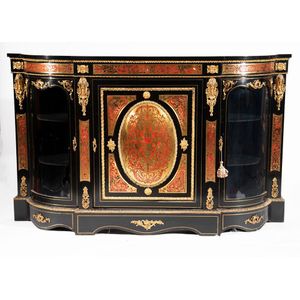Boulle Breakfront Credenza with Ormolu Mounts
You must be a subscriber, and be logged in to view price and dealer details.
Subscribe Now to view actual auction price for this item
When you subscribe, you have the option of setting the currency in which to display prices to $Au, $US, $NZ or Stg.
- Mounts - Mounts are used to describe bronze, brass and ormolu adornments on furniture especially quality furniture in the rococo and classical revival style, and are also the cabinet makers' name for the metal fittings on furniture, such as hinges, locks and handles, and metal edges and guards which protect furniture from damage.
- Ormolu - Ormolu was popular with French craftsmen in the 18th and 19th century for ornamental fittings for furniture, clocks and other decorative items. True ormolu is gilt bronze, that is bronze that has been coated with gold using a mercury amalgam. Due to the health risks associated with using mercury, this method of creating ormolu was discontinued in France in the 1830s. A substitute was developed consisting of about 75% copper and 25% zinc, however it was inferior to the bronze version. It was often lacquered to prevent it tarnishing.
- Breakfront - A design generally found in larger pieces of furniture, such as bookcases, wardrobes and some sideboards. The line of the front is interrupted by the middle section standing out from each end. In a reverse breakfront, the centre section is recessed behind each end. Breakfronted pieces are usually made in three sections the middle and the two wings which are held together by the cornice and pediment, and the plinth on which it stands. The sensible buyer should show caution before buying breakfront pieces, especially bookcases, which are highly desirable and expensive. Always check that the timber, colour, patination, backboards, decoration and thickness of the wood are same in each section.
- Boulle - Boulle work is the name given to tortoiseshell and metal inlay using brass and sometimes silver, found on furniture and smaller wooden objects. It originated in Italy but was developed by Frenchman Andre Charles Boulle (1642 - 1732) under Louis XIV.
Boulle was appointed Royal Cainet Maker to Louis XIV and designed furniture and clockcases for the monarch.
In preparation, the tortoiseshell and metal were cut together following a design, using a fine fret saw.
In the application of the Boulle, the carcase of piece of furniture was covered with the tortoiseshell which in turn was inlaid with the matched designs in metal, which in turn was elaborately engraved.
The use of Boulle work furniture continued mainly in France until the 19th century.
This item has been included into following indexes:
Visually similar items

A French boulle and ormolu, three door credenza late 19th century. The credenza is decorated in the 'Boulle' style with pierced-cut brass and red tortoiseshell inlay, against a black 'ebonised' patinated finish. The cabinet is serpentine shape with a centr

Napoleon III ormolu mounted and red tortoiseshell boulle credenza, late 19th century, the black serpentine shaped marble top over a pair of panelled doors profusely inlaid, enclosing two shelves, the projecting angles applied with bacchantes and satyrs, ra

A Boulle and ebonised wood bronze mounted two door cabinet, French, 19th century, 109 cm high, 128 cm wide and 43 cm deep

A 19th century ebonised and cut brass inlaid sideboard, in the boulle manner serpentine, with glazed side doors and a solid central door, finely inlaid with foliate marquetry, plinth base, 169 x 109.5 x 46 cm.
